Porting Calculator InstructionsIt works best on computers with Excel that can use macros. (Macros are stored sequences of repetitive steps that execute quickly after clicking the designated macro button which is very time saving.) The light blue data cells are where you enter information. Keep in mind that the pipe sets the engines powerband (RPM range where the engine is "on the pipe"), especially the end RPM. You can tell by feeling while riding along with a tachometer what the RPM range is of the pipes powerband. Ideally you want the engines peak power RPM to be 750 to 1500 RPM below the end of the pipes powerband. This program exists to find the engines peak power RPM and power graph and then see how they change after entering different values (such as a longer exhaust port duration with more mm above exhaust port). That helps you decide on any needed porting changes. 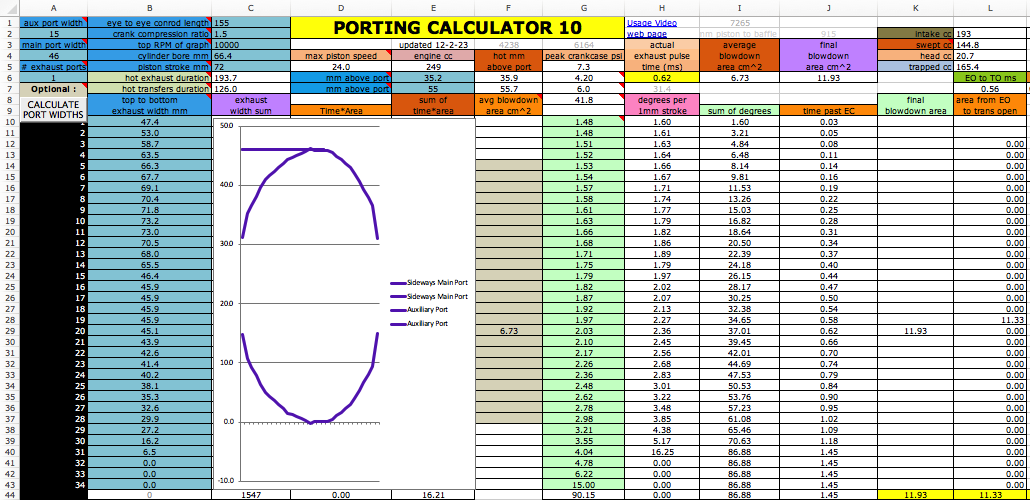  The program needs you to enter the above port mm distances for the exhaust and transfers/boost. These are from top of ports to the point on the cylinder equal to the top edge of the piston at TDC. If the transfers and boost port have staggered heights then you can use an estimated average by using the mini calculator at H151. If the graph doesn't show where the green graph goes from 1.0 to below that then enter a lower top RPM at C3 until it does. This is to know at what RPM the graph goes below 1.0 which is important to know because that is where torque starts to decrease. If too far from the end RPM set by the pipe then that is porting for a mild output, like for street or trail. If it is close to 1000 before the end RPM then it has porting for racers. That "end of torque peak" usually corresponds to the peak power RPM which is why I reference it like that. 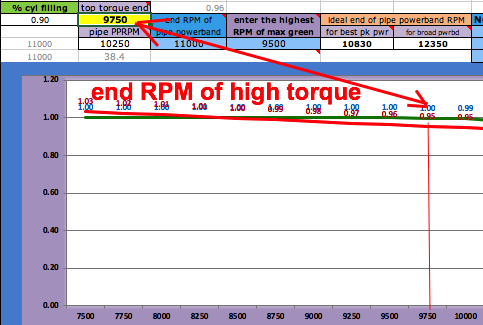 When entering RPM or any other number do not type in the comma. For example enter 9000 instead of 9,000. The port "duration" refers to how many crank degress the port is open each crank revolution. This program calculates port durations, both cold and hot, according to the above port mm you enter. Click here for an online port duration and piston height calculator. But when the conrod gets hot it extends more than the cylinder does and so the port durations lessen. The engine quickly warms up and so what it mostly experiences are the hot durations which is what this program goes by.  You can let the program give a rough estimate of the port widths every 1mm down or you can measure and enter them manually (for more precision). To calculate the estimated widths just enter the required values at A2, A4, and A6 and then click the Calculate button (macro). 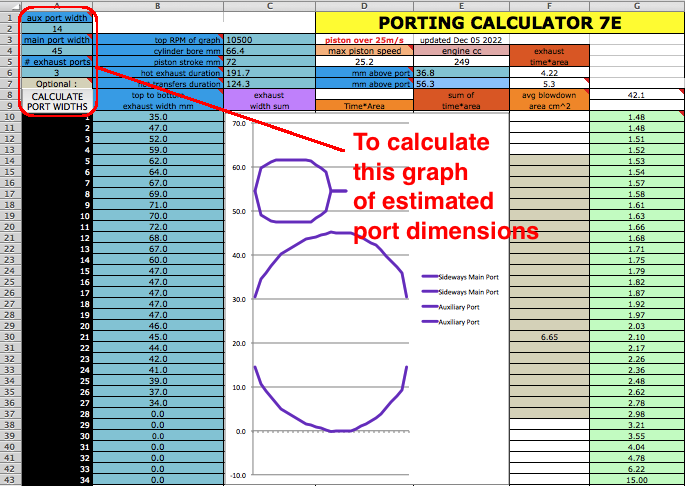 Manual Entry: Measure the exhaust port total width every 1mm down by first creating a paper trace of the exhaust port(s). 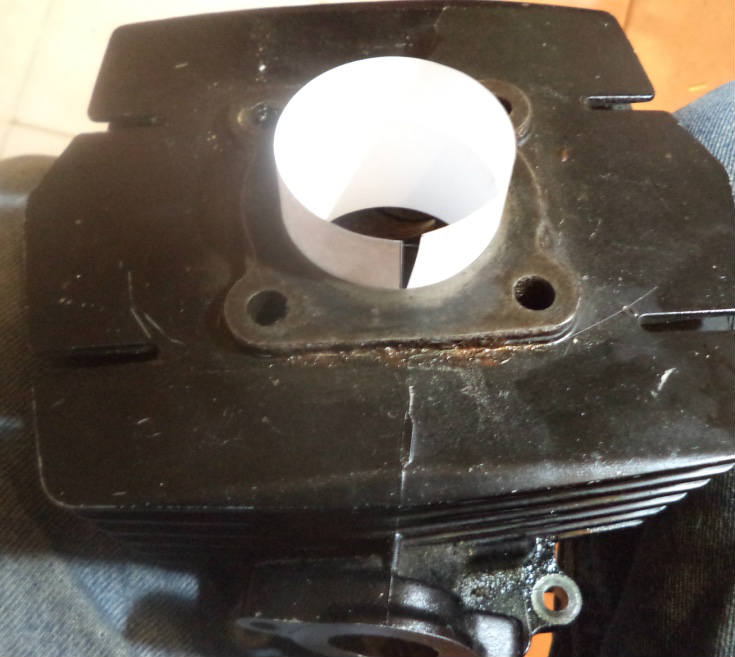 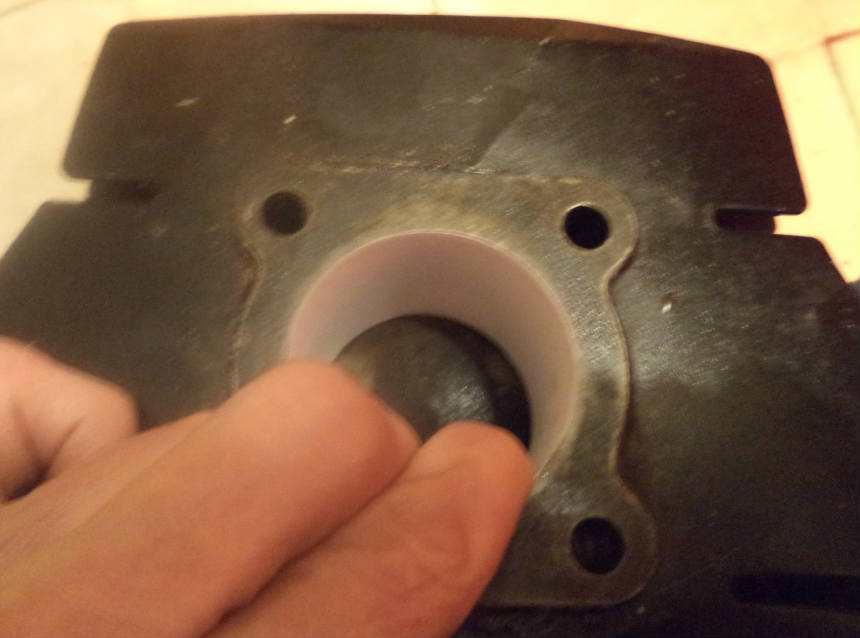 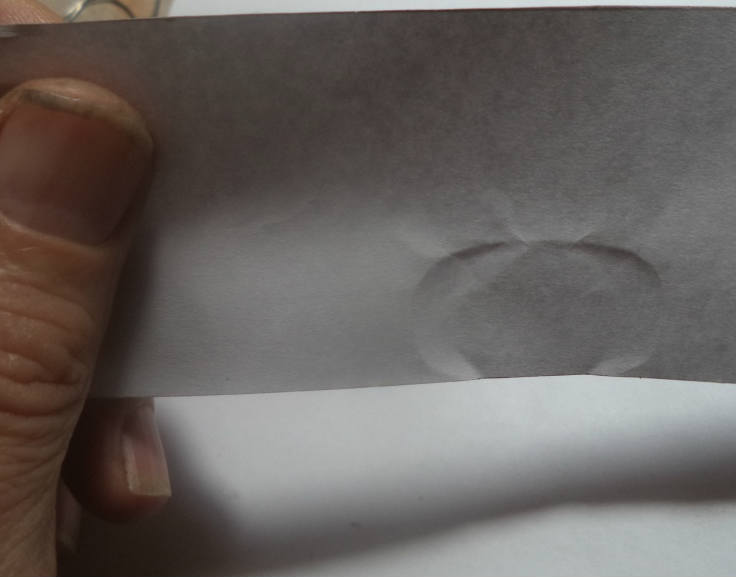 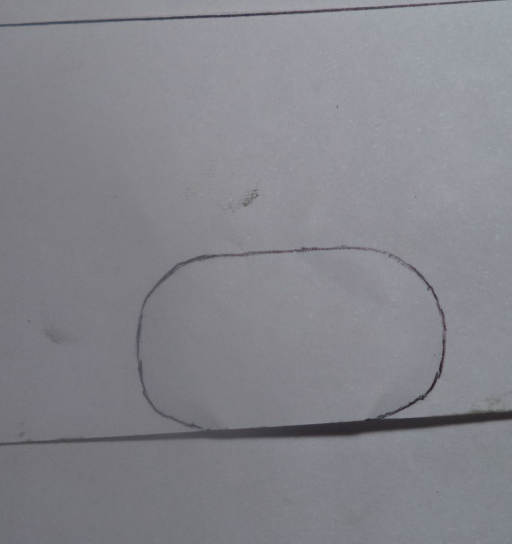 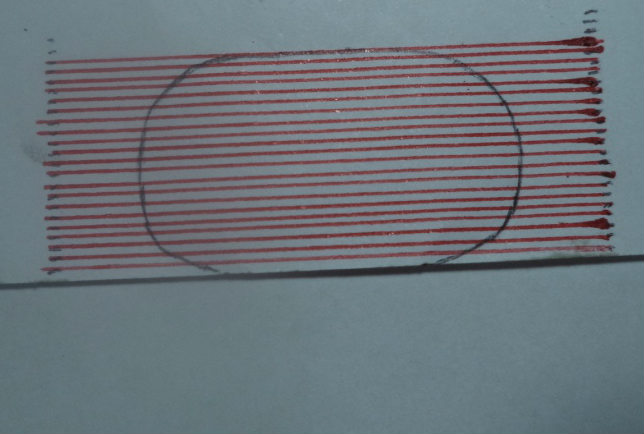 You can download a paper that has horizontal lines every 1mm down if you don't want to draw the lines on your paper trace. How to get the port trace: With cylinder removed... Just cut a rectangle of paper as tall as from the cylinder top to a bit beyond the bottom of the port. Its width should be a bit more than the cylinder diameter multiplied by 3. Insert the paper into the cylinder so that its top edge is even with the top edge of the cylinder. With cylinder on bike but head removed... Just cut a rectangle of paper as tall as from the cylinder top to the piston edge with the piston as low as it will go. Its width should be a bit more than the cylinder diameter multiplied by 3. Insert the paper into the cylinder so that its bottom edge is even with the top edge of the piston. Then spread the paper apart so it is pressing against all of the cylinder and then hold it in place where the paper overlaps itself. Then reach in and press your thumb onto the paper where you think the top of the port is. Once you can feel the top edge then press hard on the edge without pushing the paper into the exhaust port. Do this all along the exhaust ports edges. Remove the paper and enhance the trace with an ink pen. Mark along both sides of the ports every 1mm and use ruler and pen to connect the marks. Then use your ruler to measure each port width for each 1mm and write them down as illustrated below. It's not necessary to go all the way to the bottom of the port.  Sum each row of the three columns and enter each total in PortCalc with top port width at B10 and then sequencing down. Make sure only zeroes are under the last width you enter. 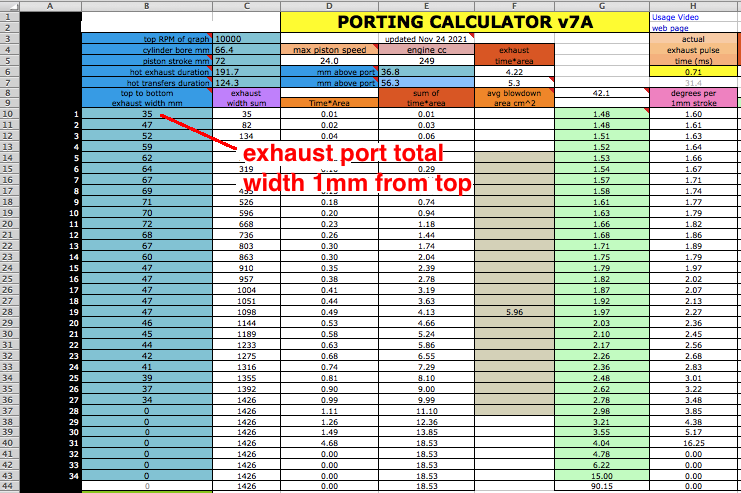 Using the same paper trace of the transfer ports you need to add up all of the transfer port widths, from both left and right side of cylinder, excluding the rear boost ports. Enter the total at C52. 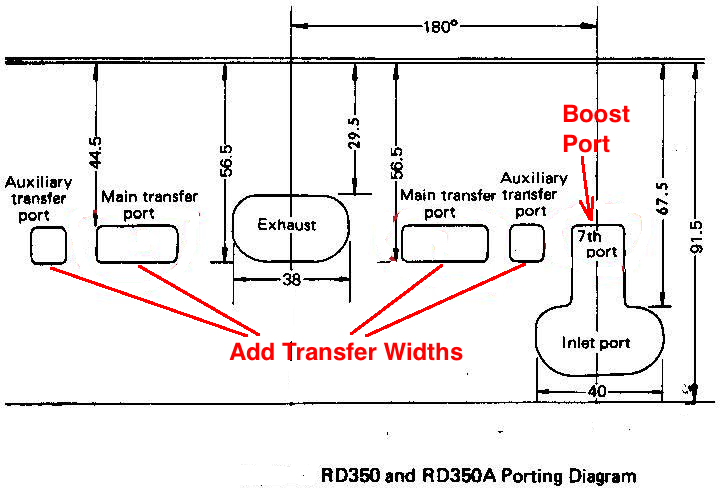 Enter the total width of all boost ports at C53. Enter the boost port depth at D51 and the angle at D49 (which is close to 30 degrees typically). At the bottom left of the calculator is a Boost Port Angle Finder to help you know the port angle.  The red graph shows where the combustion pressure ends in relation to the beginning of transfers opening. For the red graph the horizontal 1.00 line indicates transfers opening time. Being higher than the horizontal 1.00 line indicates the combustion pressure ends before transfers opening. Being lower than 1.00 indicates it ends after transfers opening (which hinders flow into combustion chamber from the transfers). It is a fraction of the transfer time (from opening till BDC) so that .80 means the combustion pressure dissipates when the piston edge is at 80% of the remaining port time till BDC. The fraction at C50 (% exhaust-free transfer) is the red graph value at the RPM at C54 (the last RPM of graph). It shouldn't be less than .92 at peak power RPM, or less than .80 at the end RPM. The green graph shows the fraction of cylinder filling, essentially the delivery ratio. This shows 1.00 when the time*area of the transfer ports is enough for optimal cylinder filling. It also takes into account that the transfer only starts after the combustion pressure has reduced to near zero. At H6 you can see the calculated time it takes for the combustion pressure to dissipate after exhaust port opening. So where the green graph descends from 1.00 indicates the portings raw peak power RPM, the end of peak torque. 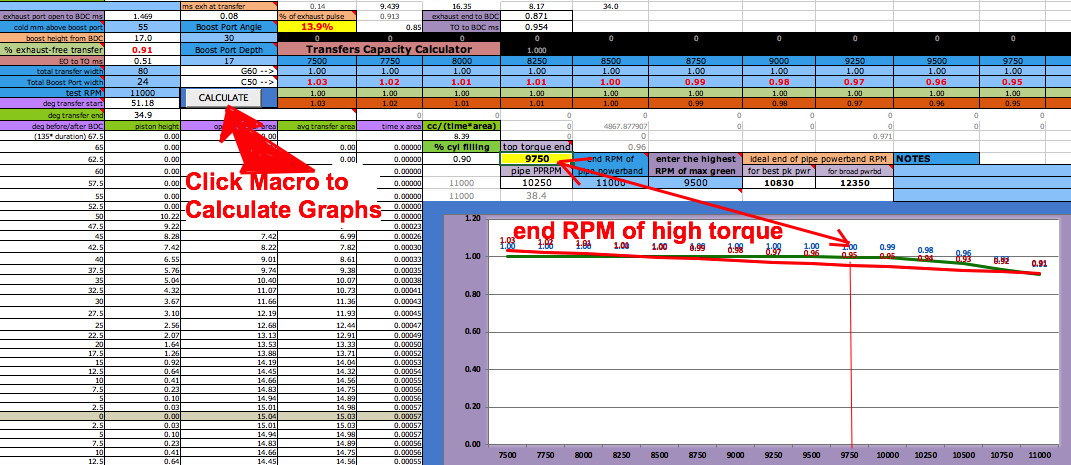 Click the Calculate button at D54 to generate the red and green graphs. If you can't use macros then just enter the displayed RPM at E51 into C54 then enter the value from G60 into E52, and the value from C50 into E53. Repeat for the next RPM (250 higher): Enter the displayed RPM at F51 into C54 then enter the value from G60 into F52, and the value from C50 into F53. Do this for every increment of 250 RPM (till T51) and then read the peak power RPM at H60. The green graph is most important but it is affected by the red graph. H60 shows the current peak power RPM (PPRPM) of engine. This graph shows how much the exhaust pulse overlapping the transfers opening affects the potential peak power RPM of the engine. For instance, if the exhaust pulse exists till 15% of transfer opening time (85% transfer time remains till BDC) then that causes a 19% reduction (x.81) of PPRPM. So it is important to not let the transfer be hampered by the combustion pressure by providing enough blowdown. 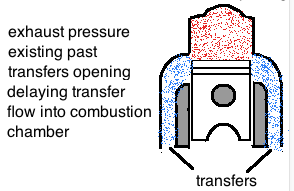 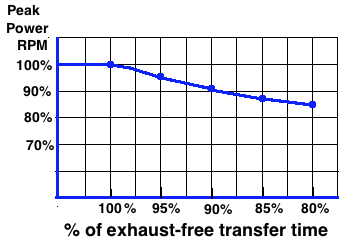 If the graph doesn't show where the green graph descends from the 1.0 horizontal line then at I63 the program will tell you to lower or raise the RPM at C3 till that descent shows on the graph. But first take note at E48 what % of the exhaust pulse overlaps the transfer opening (for the RPM at C54) with the engines real top RPM entered at C3. If that is more than 22% at top RPM then you need to raise and/or widen the exhaust port. If it is less than 0% then the exhaust port is too high. More than a 22% overlap causes a message to appear at D56 telling you to raise/widen the exhaust port. 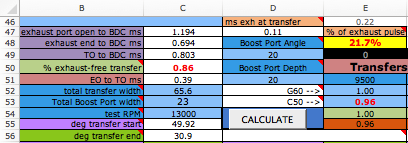 When you hover the pointer over cells with a top right red corner then its comments will display. Below shows some of the most important comments. 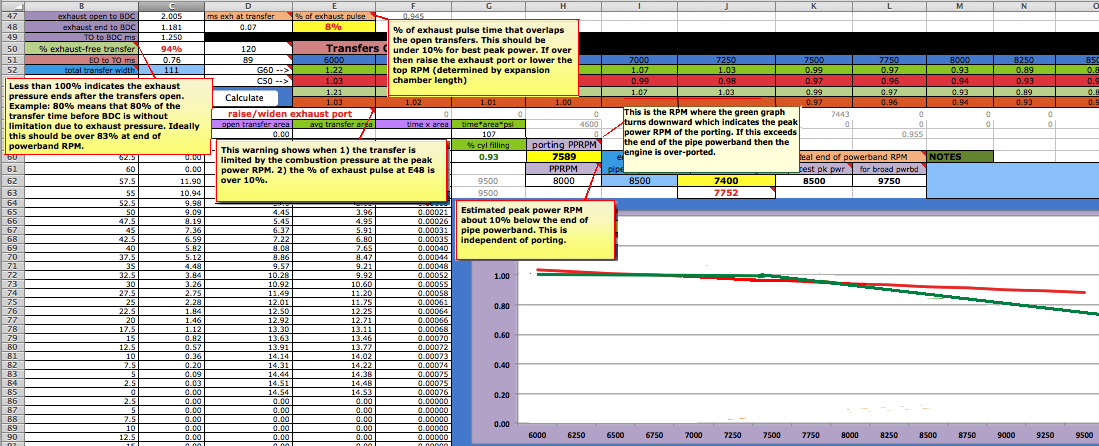 When deciding on port duration changes try to change them so that the green graph descends from 1.00 close to .9 times the pipes end of powerband RPM if you want the best peak power with no concern for loss of lower RPM power. Usually with a single port exhaust you can't do that. You have to settle for a peak power RPM much lower. With this type engine it is normal for the engines peak power RPM to be 60% that of the pipes end of powerband RPM which is terrible for peak power but gives a longer powerband. Here's a real life example with the continuation of raw engine power as the dotted blue line. The green graphs rise above it is due to pipe boost. Notice how the final peak power is about 700 RPM less than the pipes end of powerband RPM and 400 RPM more than the engines raw peak power RPM. It's possible that a higher peak power and narrower powerband can be had by making the engines raw peak power RPM (as determined by the porting calculator) 500 RPM less than the pipes end of powerband RPM (as determined by the expansion chamber calculator) but I think the result that this dyno is showing has the best combination of the two. It has slightly less peak power but a longer powerband. 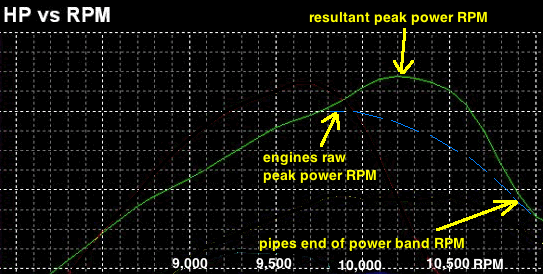 Unlike my predecessors I am not listing any port duration charts because they are all just too generic to be of any real use. If you want to do something right then don't take such shortcuts. Each engine needs to be analyzed with calculators such as this one. And be aware that the formulas and method used here are unique to this program. Here's a customer report: "Yesterday I completed around 145 km riding my bike with the ported cylinders using your program. It was such wonderful power delivery starting from 3000 RPM and above, especially in hilly areas. I'm really happy and proud using your program for cylinder porting, such perfect calculations giving a wonderful output." Is there a way to tell if you've raised the exhaust too much causing a loss in power? - Probably if the port is so high that there is very little transfer overlap at peak power RPM then that would be bad. But I'd have to experiment with a cylinder to verify this. idea. April 2024 Update - Now to the right of the main graph is an engine power graph. Going by this graph is even more helpful than going by the green graph. Here's a video explaining more: https://youtu.be/cUlQXXbRjXY HOME |